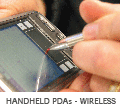Camera
Introduction
An image sensor is a device which converts a visual image, in the form of light, into electronic signals which can be interpreted by a computer. Image sensors form the basic workings of digital cameras. Digital cameras designed for embedded use are typically very small, with lens sizes of only a few millimetres, while still maintaining reasonably high resolutions. The focal range of embedded cameras is not as good as most professional cameras. Embedded cameras are often fixed-focus, meaning that in order to get a sharp image the subject needs to be at a specific distance from the camera. Newer embedded cameras are auto, or manual focus, but the focal range is still limited compared to professional cameras.
Image Sensor Specifications
There are a number of factors to consider when selecting an image sensor for use in an embedded device. Some of the more important issues are outlined below:
CMOS vs CCD
There are two major technologies used in image sensors called CCD (Charge Coupled Device) and CMOS (Complementary Metal Oxide Semiconductor). The two technologies have various advantages and disadvantages in different situations. Both CCD and CMOS are used to convert light into electrical signals which can be processed by a computer.
CCD image sensors transfer the pixel charge of every pixel through a small number, often only one, of output nodes. The output nodes are responsible for converting the light information into electrical signals. Because all of the pixels are fed through a small number of output nodes, the conversion of the pixels is handled in a very uniform manner.
CMOS image sensors have individual conversion circuit for each pixel. CMOS image sensors often include additional logic for amplification, noise filtering and digitisation. CMOS image sensors are more complex, and typically larger than CCD sensors, however they require less processing outside of the image sensor circuit.
An in-depth comparison of CMOS and CCD can be found at: .
Mega-pixels
The number of pixels for an image sensors refers to the number of individual red, green and blue sensors present in the image sensor, and is usually measured in mega-pixels (one million pixels). Two double the resolution of an image sensor the number of mega-pixels must be multiplied by two in both the horizontal and vertical directions. For example a 16 mega-pixel camera is twice the resolution of a 4 mega-pixel camera. The following table gives a rough indication of the number of mega-pixels required to produce decent images at various resolutions:
| Image Resolution | Mega-pixels |
|---|---|
| 800x600 | 0.5 |
| 1280x1024 | 1.3 |
| 1800x1200 | 2.5 |
| 2500x2000 | 5.0 |
A mega-pixel calculator is available at: http://web.forret.com/tools/megapixel.asp. A larger number of mega-pixels gives a higher resolution image, but will also result in much larger image files especially when stored in raw (no compression) format. For example, at 16 bits per pixel, an uncompressed 800x600 image is under one megabyte, whereas a 2500x2000 image is around 9.5 megabyte. Choice of mega-pixel number , and whether or not to use compression is a trade-off between quality and the amount of images that can be stored on a device.
Lens Size
The lens size is important, because even if an image sensor has a large number of mega-pixels, if the lens size is small then each of the pixels will only receive a small amount of light and the image quality will be poor. An article at http://photo.net/equipment/digital/sensorsize/ compares three digital image sensors which have the same number of pixels, but different lens sizes.
Bayer Filter
Image sensors give image data in an RGBG pixel arrangement, where each pixel can only provide a single colour intensity (red/green/blue). This means that each group of four pixels is combined to give the final actual pixel information. giving twice as much green colour information as red/blue. this arrangement takes advantage of the fact that humans perceive the brightness of an object mostly from the presence of green and that we have better perception of brightness than hue or saturation. A 1 mega-pixel image sensor will have 250,000 red and blue sensors and 500,000 green sensors.
Embedded Cameras


End User applications
Bluewater Systems Experience
MT9T001 - 1/2-Inch 3-Megapixel Digital Image Sensor
Supported on:
- 255 (via custom FPGA interface)
- 270 (via camera interface)
- AT91sam9260 (via camera interface)
Can also be provided as a compact flash adapter, for use in any compact flash standards compliant device
Digital Camera on Rig200
If using the Snapper270 module, the camera interface is exposed via a flat-flex connector, and






